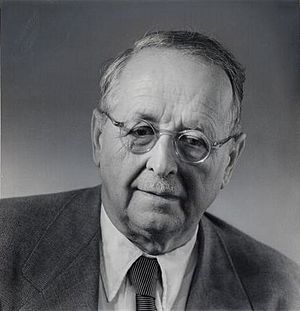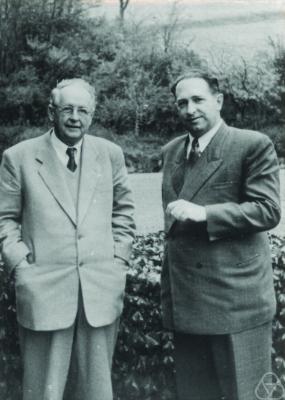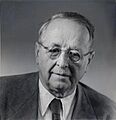Hermann Weyl facts for kids
Quick facts for kids
Hermann Weyl
|
|
|---|---|
 |
|
| Born |
Hermann Klaus Hugo Weyl
9 November 1885 Elmshorn, German Empire
|
| Died | 8 December 1955 (aged 70) |
| Nationality | German |
| Alma mater | University of Göttingen |
| Known for | List of topics named after Hermann Weyl Ontic structural realism Wormhole |
| Spouse(s) | Friederike Bertha Helene Joseph (nickname "Hella") (1893–1948) Ellen Bär (née Lohnstein) (1902–1988) |
| Children | Fritz Joachim Weyl (1915–1977) Michael Weyl (1917–2011) |
| Awards | Fellow of the Royal Society Lobachevsky Prize (1927) Gibbs Lecture (1948) |
| Scientific career | |
| Fields | Pure mathematics, Mathematical physics |
| Institutions | Institute for Advanced Study University of Göttingen ETH Zürich |
| Thesis | Singuläre Integralgleichungen mit besonder Berücksichtigung des Fourierschen Integraltheorems (1908) |
| Doctoral advisor | David Hilbert |
| Doctoral students | Alexander Weinstein |
| Other notable students | Saunders Mac Lane |
| Influences | Immanuel Kant Edmund Husserl L. E. J. Brouwer |
| Signature | |
Hermann Klaus Hugo Weyl (9 November 1885 – 8 December 1955) was a German mathematician, theoretical physicist, and philosopher. He spent much of his working life in Zürich, Switzerland, and later in Princeton, New Jersey, USA. He is often linked to the University of Göttingen's famous mathematics tradition, which included great minds like Carl Friedrich Gauss and David Hilbert.
Weyl's research was very important for both theoretical physics and pure mathematics, such as number theory. He is considered one of the most important mathematicians of the twentieth century. He was also a key member of the Institute for Advanced Study when it first started.
Hermann Weyl worked on many different areas of mathematics. These included ideas about space, time, matter, philosophy, logic, symmetry, and the history of mathematics. He was one of the first scientists to try and combine general relativity with the rules of electromagnetism. Famous scientists like Freeman Dyson and Michael Atiyah have said that Weyl's work was incredibly broad and deep.
About Hermann Weyl
Early Life and Education
Hermann Weyl was born on November 9, 1885, in Elmshorn, a small town near Hamburg, Germany. His father, Ludwig Weyl, was a banker, and his mother, Anna Weyl, came from a wealthy family.
He went to the Gymnasium Christianeum in Altona. From 1904 to 1908, he studied mathematics and physics at both Göttingen and Munich universities. He earned his doctorate degree from the University of Göttingen. His main teacher and mentor was the famous mathematician David Hilbert, whom Weyl greatly admired.
Family Life
In September 1913, Weyl married Friederike Bertha Helene Joseph, known as Helene. Helene was a philosopher and translated Spanish literature. She was a student of the philosopher Edmund Husserl. Through Helene, Hermann became very interested in Husserl's ideas, which influenced his own thinking.
Hermann and Helene had two sons, Fritz Joachim Weyl and Michael Weyl. Both were born in Zürich, Switzerland. Helene passed away in 1948. In 1950, Hermann married Ellen Bär, a sculptress.
Career and Moving to the US
After teaching for a few years, Weyl moved to Zürich in 1913. He became a professor of mathematics at the ETH Zürich. There, he worked with Albert Einstein, who was developing his theory of general relativity. Einstein's work greatly influenced Weyl, and he became very interested in mathematical physics. In 1921, Weyl became close friends with theoretical physicist Erwin Schrödinger.
Weyl was a speaker at important international meetings for mathematicians in 1928 and 1936. He was also chosen as a member of the American Physical Society and the National Academy of Sciences.
In 1930, Weyl returned to Göttingen to take over from his former teacher, David Hilbert. However, when the Nazis came to power in 1933, Weyl left Germany. His wife, Helene, was Jewish, which made it unsafe for them. He had been offered a job at the new Institute for Advanced Study in Princeton, New Jersey, earlier but had said no. With the political situation in Germany getting worse, he changed his mind and accepted the offer. He stayed in Princeton until he retired in 1951.
After retiring, he split his time between Princeton and Zürich. He passed away from a heart attack in Zürich on December 8, 1955. His ashes were later buried in the Princeton Cemetery in 1999, next to his son Michael Weyl. Hermann Weyl believed in Pantheism, a view that God is the same as the universe.
Key Contributions to Science
Hermann Weyl made many important contributions to mathematics and physics. He helped shape how we understand many complex ideas.
Understanding Eigenvalues
In 1911, Weyl published a paper about how "eigenvalues" are spread out. Eigenvalues are special numbers that describe how certain mathematical systems behave, like how a drum vibrates. He showed how these numbers are distributed in a specific way, which is now called the Weyl law. This work started a very important field of study in modern mathematics.
Geometry in Space and Physics
In 1913, Weyl wrote a book called The Concept of a Riemann Surface. This book helped to explain Riemann surfaces in a clear way. Riemann surfaces are like special curved surfaces that help mathematicians understand complex numbers. Weyl used new ideas from point set topology to make this theory more exact.
Weyl was very aware of Einstein's work on general relativity from the beginning. He wrote a book called Space, Time, Matter in 1918, which explained the physics of relativity. In 1918, he also introduced the idea of "gauge" and created the first example of a gauge theory. This was an early attempt to describe both electromagnetic and gravitational fields as geometric features of spacetime. The Weyl tensor in geometry is also very important for understanding shapes in space.
Groups and Symmetries
From 1923 to 1938, Weyl developed the theory of compact groups using matrix representations. These ideas are fundamental for understanding the symmetry in quantum mechanics, which is the study of very tiny particles. His work helped explain how symmetries work in the quantum world.
His book The Classical Groups looked at invariant theory. It covered different types of groups, like symmetric groups and orthogonal groups, and how their symmetries behave.
Foundations of Mathematics
In his book The Continuum, Weyl explored the basic rules of mathematics. He tried to build calculus using a simpler logic, without relying on certain complex mathematical ideas like the axiom of choice or proof by contradiction. He also tried to avoid Georg Cantor's ideas about infinite sets.
For a short time, Weyl became a strong supporter of intuitionism, a mathematical philosophy that says mathematical objects only exist if they can be built or constructed. He even wrote a controversial article calling for a "revolution" in mathematics. However, he later felt that intuitionism was too limiting for mathematics.
By 1949, Weyl had become less enthusiastic about intuitionism. He wrote that while intuitionism made mathematics clearer, it also made advanced theories very difficult to work with. He felt that much of the grand structure of mathematics seemed to "dissolve into mist" under intuitionistic rules.
The Weyl Equation
In 1929, Weyl proposed an equation known as the Weyl equation. This equation describes fermions that have no mass. A normal Dirac fermion (a type of particle) can be thought of as two Weyl fermions, or it can be formed from them. For a while, Neutrinos were thought to be Weyl fermions, but we now know they have a small mass. Scientists are looking for Weyl fermions for use in new electronic devices. In 2015, "quasiparticles" (which behave like particles) that act like Weyl fermions were found in special crystals called Weyl semimetals.
Famous Quotes
- "The question for the ultimate foundations and the ultimate meaning of mathematics remains open; we do not know in which direction it will find its final solution nor even whether a final objective answer can be expected at all. 'Mathematizing' may well be a creative activity of man, like language or music, of primary originality, whose historical decisions defy complete objective rationalization."
- "In these days the angel of topology and the devil of abstract algebra fight for the soul of each individual mathematical domain."
- "Whenever you have to do with a structure-endowed entity S try to determine its group of automorphisms, the group of those element-wise transformations which leave all structural relations undisturbed. You can expect to gain a deep insight into the constitution of S in this way."
See also
 In Spanish: Hermann Weyl para niños
In Spanish: Hermann Weyl para niños
Things Named After Hermann Weyl
- Majorana–Weyl spinor
- Peter–Weyl theorem
- Schur–Weyl duality
- Weyl algebra
- Weyl basis of the gamma matrices
- Weyl chamber
- Weyl character formula
- Weyl equation, a relativistic wave equation
- Weyl expansion
- Weyl fermion
- Weyl gauge
- Weyl gravity
- Weyl notation
- Weyl quantization
- Weyl spinor
- Weyl sum, a type of exponential sum
- Weyl symmetry: see Weyl transformation
- Weyl tensor
- Weyl transform
- Weyl transformation
- Weyl–Schouten theorem
- Weyl's criterion
- Weyl's lemma on hypoellipticity
- Weyl's lemma on the "very weak" form of the Laplace equation
Images for kids




